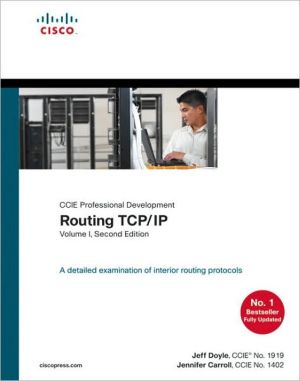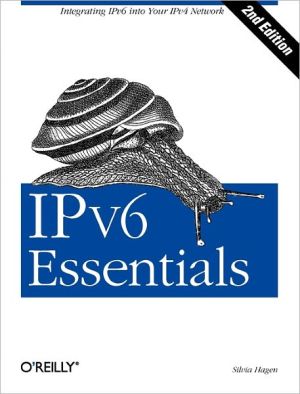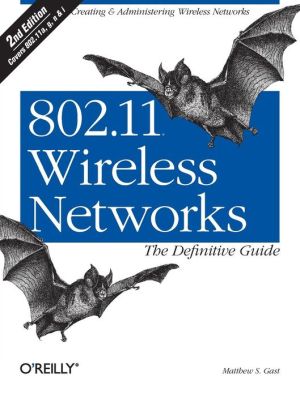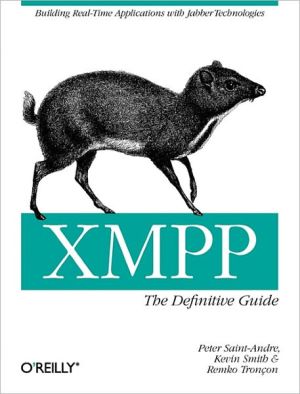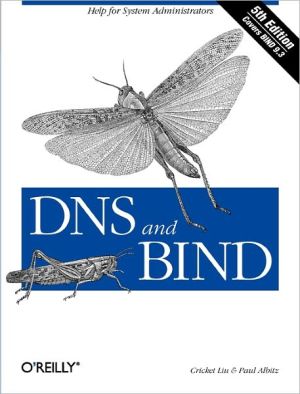Routing TCP/IP, Volume 1
A detailed examination of interior routing protocols -- completely updated in a new edition A complete revision of the best-selling first edition--widely considered a premier text on TCP/IP routing protocols A core textbook for CCIE preparation and a practical reference for network designers, administrators, and engineers Includes configuration and troubleshooting lessons that would cost thousands to learn in a classroom and numerous real-world examples and case studies Praised in its...
Search in google:
A detailed examination of interior routing protocols — completely updated in a new editionA complete revision of the best-selling first edition—widely considered a premier text on TCP/IP routing protocols A core textbook for CCIE preparation and a practical reference for network designers, administrators, and engineers Includes configuration and troubleshooting lessons that would cost thousands to learn in a classroom and numerous real-world examples and case studiesPraised in its first edition for its approachable style and wealth of information, this new edition provides readers a deep understanding of IP routing protocols, teaches how to implement these protocols using Cisco routers, and brings readers up to date protocol and implementation enhancements. Routing TCP/IP, Volume 1, Second Edition, includes protocol changes and Cisco features that enhance routing integrity, secure routers from attacks initiated through routing protocols, and provide greater control over the propagation of routing information for all the IP interior routing protocols. Routing TCP/IP, Volume 1, Second Edition, provides a detailed analysis of each of the IP interior gateway protocols (IGPs). Its structure remains the same as the best-selling first edition, though information within each section is enhanced and modified to include the new developments in routing protocols and Cisco implementations. What's New In This Edition? The first edition covers routing protocols as they existed in 1998. The new book updates all covered routing protocols and discusses new features integrated in the latest version of Cisco IOS Software. IPv6, its use with interior routing protocols, and its interoperability and integration with IPv4 are also integrated into this book. Approximately 200 pages of new information are added to the main text, with some old text removed. Additional exercise and solutions are also included.
Part I Routing BasicsChapter 1 TCP/IP ReviewTCP/IP Protocol LayersIP Packet HeaderIPv4 AddressesFirst Octet RuleAddress MasksSubnets and Subnet MasksDesigning SubnetsBreaking the Octet BoundaryTroubleshooting a Subnet MaskAddress Resolution Protocol (ARP)Proxy ARPGratuitous ARPReverse ARPInternet Control Message Protocol (ICMP)Host-to-Host LayerTCPUDPLooking AheadSummary Table: Chapter 1 Command ReviewRecommended ReadingReview QuestionsConfiguration ExercisesTroubleshooting ExercisesChapter 2 IPv6 OverviewIPv6 AddressesAddress RepresentationIPv6 Address TypesGlobal Unicast AddressesIdentifying IPv6 Address TypesLocal Unicast AddressesAnycast AddressesMulticast AddressesEmbedded IPv4 AddressesIPv6 Packet Header FormatExtension HeadersICMPv6Neighbor Discovery ProtocolNDP MessagesRouter DiscoveryAddress AutoconfigurationDuplicate Address DetectionNeighbor Address ResolutionPrivacy AddressesNeighbor Unreachability DetectionLooking AheadReview QuestionsChapter 3 Static RoutingRoute TableConfiguring Static RoutesCase Study: Simple IPv4 Static RoutesCase Study: Simple IPv6 Static RoutesCase Study: Summary RoutesCase Study: Alternative RoutesCase Study: Floating Static RoutesCase Study: IPv6 Floating Static RoutesCase Study: Load SharingLoad Sharing and Cisco Express ForwardingPer Destination Load Sharing and Fast SwitchingPer Packet Load Sharing and Process SwitchingWhich Switching Method Will Be Used?Case Study: Recursive Table LookupsTroubleshooting Static RoutesCase Study: Tracing a Failed RouteCase Study: A Protocol ConflictCase Study: A Replaced RouterCase Study: Tracing An IPv6 Failed RouteLooking AheadSummary Table: Chapter 3 Command ReviewReview QuestionsConfiguration ExercisesTroubleshooting ExercisesChapter 4 Dynamic Routing ProtocolsRouting Protocol BasicsPath DeterminationMetricsHop CountBandwidthLoadDelayReliabilityCostConvergenceLoad BalancingDistance Vector Routing ProtocolsCommon CharacteristicsPeriodic UpdatesNeighborsBroadcast UpdatesFull Routing Table UpdatesRouting by RumorRoute Invalidation TimersSplit HorizonCounting to InfinityTriggered UpdatesHolddown TimersAsynchronous UpdatesLink State Routing ProtocolsNeighborsLink State FloodingSequence NumbersAgingLink State DatabaseSPF AlgorithmAreasInterior and Exterior Gateway ProtocolsStatic or Dynamic Routing?Looking AheadRecommended ReadingReview QuestionsPart II Interior Routing ProtocolsChapter 5 Routing Information Protocol (RIP)Operation of RIPRIP Timers and Stability FeaturesRIP Message FormatRequest Message TypesClassful RoutingClassful Routing: Directly Connected SubnetsClassful Routing: Summarization at Boundary RoutersClassful Routing: SummaryConfiguring RIPCase Study: A Basic RIP ConfigurationCase Study: Passive InterfacesCase Study: Configuring Unicast UpdatesCase Study: Discontiguous SubnetsCase Study: Manipulating RIP MetricsCase Study: Minimizing the Impact of UpdatesTroubleshooting RIPLooking AheadSummary Table: Chapter 5 Command ReviewRecommended ReadingReview QuestionsConfiguration ExercisesTroubleshooting ExercisesChapter 6 RIPv2, RIPng, and Classless RoutingOperation of RIPv2RIPv2 Message FormatCompatibility with RIPv1Classless Route LookupsClassless Routing ProtocolsVariable-Length Subnet MaskingAuthenticationOperation of RIPngConfiguring RIPv2Case Study: A Basic RIPv2 ConfigurationCase Study: Compatibility with RIPv1Case Study: Using VLSMCase Study: Discontiguous Subnets and Classless RoutingCase Study: AuthenticationConfiguring RIPngCase Study: Basic RIPng ConfigurationCase Study: RIPng Process CustomizationCase Study: Metric ManipulationCase Study: Route SummarizationTroubleshooting RIPv2 and RIPngCase Study: Misconfigured VLSMLooking AheadSummary Table: Chapter 6 Command ReviewRecommended ReadingReview QuestionsConfiguration ExercisesTroubleshooting ExercisesChapter 7 Enhanced Interior Gateway Routing Protocol (EIGRP)The Roots of EIGRP: An Overview of IGRPProcess DomainsIGRP Timers and Stability FeaturesIGRP MetricsFrom IGRP to EIGRPOperation of EIGRPProtocol-Dependent ModulesReliable Transport ProtocolNeighbor Discovery/RecoveryDiffusing Update AlgorithmDUAL: Preliminary ConceptsDUAL Finite State MachineDiffusing Computation: Example 1Diffusing Computation: Example 2EIGRP Packet FormatsEIGRP Packet HeaderGeneral TLV FieldsIP-Specific TLV FieldsAddress AggregationEIGRP and IPv6Configuring EIGRPCase Study: A Basic EIGRP ConfigurationCase Study: Unequal-Cost Load BalancingCase Study: Setting Maximum PathsCase Study: Multiple EIGRP ProcessesCase Study: Disabling Automatic SummarizationCase Study: Stub RoutingCase Study: Address SummarizationAuthenticationTroubleshooting EIGRPCase Study: A Missing NeighborStuck-in-Active NeighborsLooking AheadSummary Table: Chapter 7 Command ReviewReview QuestionsConfiguration ExercisesTroubleshooting ExercisesChapter 8 OSPFv2Operation of OSPFNeighbors and AdjacenciesHello ProtocolNetwork TypesDesignated Routers and Backup Designated RoutersOSPF InterfacesOSPF NeighborsFloodingAreasRouter TypesPartitioned AreasVirtual LinksLink-State DatabaseLSA TypesStub AreasRoute TableDestination TypesPath TypesRoute Table LookupsAuthenticationOSPF over Demand CircuitsOSPF Packet FormatsPacket HeaderHello PacketDatabase Description PacketLink State Request PacketLink State Update PacketLink State Acknowledgment PacketOSPF LSA FormatsLSA HeaderRouter LSANetwork LSANetwork and ASBR Summary LSAsAutonomous System External LSANSSA External LSAOptions FieldConfiguring OSPFCase Study: A Basic OSPF ConfigurationCase Study: Setting Router IDs with Loopback InterfacesCase Study: Domain Name Service LookupsCase Study: OSPF and Secondary AddressesCase Study: Stub AreasCase Study: Totally Stubby AreasCase Study: Not-So-Stubby AreasCase Study: Address SummarizationCase Study: Filtering Between AreasCase Study: AuthenticationCase Study: Virtual LinksCase Study: OSPF on NBMA NetworksCase Study: OSPF over Demand CircuitsTroubleshooting OSPFCase Study: An Isolated AreaCase Study: Misconfigured SummarizationLooking AheadSummary Table: Chapter 8 Command ReviewRecommended ReadingReview QuestionsConfiguration ExercisesTroubleshooting ExercisesChapter 9 OSPFv3Operation of OSPFv3OSPFv3 Differences from OSPFv2OSPFv3 MessagesAn Overview of OSPFv3 LSAsOSPFv3 LSA FormatsThe Router LSANetwork LSAInter-Area Prefix LSAInter-Area Router LSAAS-External LSALink LSA 489Intra-Area Prefix LSAOptions FieldConfiguring OSPFv3Case Study: A Basic OSPFv3 ConfigurationCase Study: Stub AreasCase Study: Multiple Instances on a LinkCase Study: OSPFv3 on NBMA NetworksTroubleshooting OSPFv3Case Study: Frame-Relay MappingLooking Ahead 509Summary Table: Chapter 9 Command ReviewRecommended ReadingReview QuestionsConfiguration ExercisesChapter 10 Integrated IS-ISOperation of Integrated IS-ISIS-IS AreasNetwork Entity TitlesIS-IS Functional OrganizationSubnetwork Dependent FunctionsSubnetwork Independent FunctionsIS-IS PDU FormatsTLV FieldsIS-IS Hello PDU FormatIS-IS Link State PDU FormatIS-IS Sequence Numbers PDU FormatExtensions to IS-IS3-Way HandshakingDomain-Wide Prefix DistributionWide MetricsRouting IPv6 with IS-ISDynamic Hostname ExchangeMultiple TopologiesMesh GroupsFlooding DelaysImproving SPF EfficiencyConfiguring Integrated IS-ISCase Study: A Basic IPv4 Integrated IS-IS ConfigurationCase Study: Changing the Router TypesCase Study: An Area MigrationCase Study: Route SummarizationCase Study: AuthenticationCase Study: A Basic Integrated IS-IS Configuration for IPv6Case Study: Transition to Multiple Topology ModeCase Study: Route Leaking Between LevelsCase Study: Multiple L1 Areas Active on A RouterTroubleshooting Integrated IS-ISTroubleshooting IS-IS AdjacenciesTroubleshooting the IS-IS Link-State DatabaseCase Study: Integrated IS-IS on NBMA NetworksLooking AheadSummary Table: Chapter 10 Command ReviewReview QuestionsConfiguration ExercisesTroubleshooting ExercisesPart III Route Control and InteroperabilityChapter 11 Route RedistributionPrinciples of RedistributionMetricsAdministrative DistancesRedistributing from Classless to Classful ProtocolsConfiguring RedistributionCase Study: Redistributing IGRP and RIPCase Study: Redistributing EIGRP and OSPFCase Study: Redistribution and Route SummarizationCase Study: Redistributing OSPFv3 and RIPngCase Study: Redistributing IS-IS and RIP/RIPngCase Study: Redistributing Static RoutesLooking AheadSummary Table: Chapter 11 Command ReviewReview QuestionsConfiguration ExercisesTroubleshooting ExercisesChapter 12 Default Routes and On-Demand RoutingFundamentals of Default Routes 677Fundamentals of On-Demand RoutingConfiguring Default Routes and ODRCase Study: Static Default RoutesCase Study: The Default-Network CommandCase Study: The Default-Information Originate CommandCase Study: Configuring On-Demand RoutingLooking AheadSummary Table: Chapter 12 Command ReviewReview QuestionsChapter 13 Route FilteringConfiguring Route FiltersCase Study: Filtering Specific RoutesCase Study: Route Filtering and RedistributionCase Study: A Protocol MigrationCase Study: Multiple Redistribution PointsCase Study: Using Administrative Distances to Set Router PreferencesLooking AheadSummary Table: Chapter 13 Command ReviewConfiguration ExercisesTroubleshooting ExercisesChapter 14 Route MapsBasic Uses of Route MapsConfiguring Route MapsCase Study: Policy RoutingCase Study: Policy Routing and Quality of Service RoutingCase Study: Route Maps and RedistributionCase Study: Route TaggingCase Study: Filtering Tagged Routes Out of OSPF Route TableCase Study: IPv6 Redistribution with Route MapsLooking AheadSummary Table: Chapter 14 Command ReviewReview QuestionsConfiguration ExercisesTroubleshooting ExercisePart IV AppendixesAppendix A Tutorial : Working with Binary and HexAppendix B Tutorial : Access ListsAppendix C CCIE Preparation TipsAppendix D Answers to Review QuestionsAppendix E Solutions to Configuration ExercisesAppendix F Solutions to Troubleshooting Exercises1587052024TC092705
